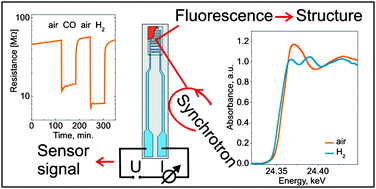Operando X-ray absorption spectroscopy studies on Pd-SnO2 based sensors†
Abstract
SnO2 gas sensors with palladium as additive in the range of 0.2 wt% and 3 wt% were studied by in situX-ray absorption

* Corresponding authors
a
Department of Materials, ETH Zürich, Wolfgang Pauli-Strasse, 10, Switzerland
E-mail:
dorota.koziej@mat.ethz.ch
b
Institute of Physical and Theoretical Chemistry, University of Tübingen, 72076 Tübingen, Germany
E-mail:
nb@ipc.uni-tuebingen.de
c European Synchrotron Radiation Facility, Grenoble, France
d
Department of Chemical and Biochemical Engineering, Technical University of Denmark, 2800 Kgs Lyngby, Denmark
E-mail:
jdg@kt.dtu.dk
Tel: +45 4525 2838
SnO2 gas sensors with palladium as additive in the range of 0.2 wt% and 3 wt% were studied by in situX-ray absorption

 Please wait while we load your content...
Something went wrong. Try again?
Please wait while we load your content...
Something went wrong. Try again?
D. Koziej, M. Hübner, N. Barsan, U. Weimar, M. Sikora and J. Grunwaldt, Phys. Chem. Chem. Phys., 2009, 11, 8620 DOI: 10.1039/B906829E
To request permission to reproduce material from this article, please go to the Copyright Clearance Center request page.
If you are an author contributing to an RSC publication, you do not need to request permission provided correct acknowledgement is given.
If you are the author of this article, you do not need to request permission to reproduce figures and diagrams provided correct acknowledgement is given. If you want to reproduce the whole article in a third-party publication (excluding your thesis/dissertation for which permission is not required) please go to the Copyright Clearance Center request page.
Read more about how to correctly acknowledge RSC content.
 Fetching data from CrossRef.
Fetching data from CrossRef.
This may take some time to load.
Loading related content
